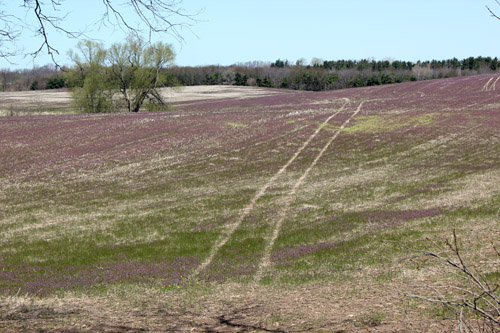Winter annual weeds may present more management and insect pest challenges this spring
Warmer than normal fall, winter and early spring temperatures along with ample precipitation has set the stage for challenges with winter annual weed growth this spring.
With warmer temperatures, winter annual weed growth is on the rise in many southwest Michigan fields. Winter annual weeds are species that begin growth during the late summer and fall, survive the winter and flower and produce seed in the spring. Common winter annual weed species in Michigan include common chickweed, henbit and purple deadnettle. Excessive growth of these species often create dense mats of vegetation that can cause challenges with spring tillage operations, reduced seed to soil contact at planting time and can keep the soil from warming and drying in early spring.
Winter annual weed species, taken 2011.
Fields infested with winter annual weeds may also increase the risk of damage from several field crop insect pests.
Black cutworms
Black cutworms overwinter in the southern states; moths are carried to the state by warm air currents or storm fronts each spring. Black cutworm moths lay eggs in fields that have significant weed growth or cover crops at the time of their arrival. In 2011, we saw severe damage in sporadic areas across southern Michigan from black cutworm larval feeding in corn fields. Chris DiFonzo outlined some of the factors that contributed to this situation in an article entitled “How to back a black cutworm cake” written in 2011. Outbreaks of black cutworm damage tend to occur when we see heavy infestations in areas to our near south (Indiana and Illinois).
White grubs (various species)
White grubs are the larval stages of several beetle pests in Michiga
White grubs overwinter in fields at depth, moving towards the soil surface as temperature warm in the spring. It is likely that the roots of winter annual weeds help provide food for the larvae until the crops develop root systems. In cases where white grub numbers are high (around one larvae per row foot), we are seeing feeding damage in corn despite insecticide seed treatment at the 250 level (Cruiser, Poncho) in fields in southwest Michigan. This damage is primarily occurring where we are seeing high levels of Asiatic garden beetles.
Application of soil insecticides at planting time, or perhaps the use of stronger seed insecticide treatments (1250 level), is important in controlling these pests. There are no effective rescue treatments for white grubs, so early detection of fields with high numbers of grubs is critical in protecting corn stands.
Seed corn maggots
Seed corn maggots are the larvae from a small species of fly that can sometimes reduce stands and seedling vigor in fields. Adult seed corn maggot females are attracted to rotting organic material at or near the soil surface. Decomposing winter annual weeds following tillage, especially chisel plowing or disking, where the green material is not completely covered with soil is often associated with incidence of seed corn maggot injury in southwest Michigan. Since virtually all commercial corn seed is treated at the 250 level with a seed insecticide, there should be less incidence of stand loss due to damage from seed corn maggots in corn than in the past. However, soybeans are also vulnerable to seed corn maggot feeding. Conditions that slow germination and seedling growth increase the risk of seed corn maggot injury.
Soybean cyst nematodes
Purple deadnettle and henbit have also been found to be alternate hosts for soybean cyst nematodes. We continue to see increases in numbers of soybean cyst nematodes in soybean production fields across Michigan. These winter annual weed species may be part of that equation.
Controlling winter annual weeds
Tillage operations and herbicide applications are the main options for keeping winter annual weed growth in check. Fall and early spring tillage, when soil moisture conditions are dry enough for tillage, can reduce the potential for negative impacts from these weeds. Timing of chemical control is important in the spring. Read an article written by MSU’s Christy Sprague discussing timing of application and herbicides to consider when making herbicide applications to no-till fields in the spring. Information on the effectiveness of herbicides for spring burndown in corn is listed in Table 1J in the 2012 MSU E-434 Bulletin “Weed Control Guide for Field Crops.” Weed management options for no-till soybeans are listed Table 2N in this publication.
For more information on weed control questions, visit MSU Field Crops Weed Control Specialist Christy Sprague’s website.
MSU’s Weed Control group has developed an excellent tool for identification of Michigan weed species. You can either click to view or purchase the IPM Pocket Guide for Weed Identification in Field Crop (E-3081) from the MSUE Bookstore.



 Print
Print Email
Email





